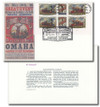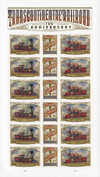
# 5378-80 - 2019 First-Class Forever Stamp - Transcontinental Railroad
US #5378-80
2019 Transcontinental Railroad
• Celebrates the 150th anniversary of the completion of the Transcontinental Railroad
• Stamp arrangement signifies the joining of eastern and western tracks at the Golden Spike Ceremony in Promontory Summit, Utah
Stamp Category: Commemorative
Value: 55¢ First Class Mail Rate (Forever)
First Day of Issue: May 10, 2019
First Day City: Promontory Summit, Utah
Quantity Issued: 50,400,000
Printed by: Banknote Corporation of America
Printing Method: Offset (with gold-foiled highlights)
Format: Panes of 18
Tagging: Phosphor, Block Tagged
Why the stamps were issued: To commemorate the 150th anniversary of the completion of the Transcontinental Railroad and its historic significance.
About the stamp designs: Stamps picture the Jupiter and No. 119 locomotives which carried officers and guests to the Golden Spike Ceremony in Promontory Summit, Utah. The third stamp pictures the ceremonial golden spike that connected the western and eastern portions of train track. Original paintings of the locomotives were by artist Michael J. Deas, while the golden spike was illustrated by Kevin Cantrell.
Special design details: All three stamps as well as the header of the pane of 18 include gold foil highlights which add to their splendid design.
First Day City: The First Day of Issue Ceremony was held at Golden Spike National Historic Site in Promontory Summit, Utah.
History the stamp represents: America’s First Transcontinental Railroad was the famous pathway connecting the East and West Coasts of the United States. It took six years to complete (1863-1869) and shortened cross-country travel from several months to just a few days.
In 2019, the USPS issued three Forever stamps commemorating the 150th anniversary of the Transcontinental Railroad. The se-tenant featured the Central Pacific Railroad’s Jupiter on the left, Union Pacific Railroad’s No. 119 on the right, and “Golden Spike” in the center.
While the original engines from 1869 were scrapped in the early 1900s, Golden Spike National Historical Park commissioned detailed replicas of the two famous locomotives. They star in the park’s daily “Golden Spike” ceremony reenactments. Since little was known about the colors of the original engines, the colors of the replicas were an educated guess. Later, a newspaper was found describing the trains as they appeared on May 10, 1869. So when it was time for the replicas to get fresh paint, new historically accurate colors were applied.
Golden Spike National Historical Park continues to share the story of the Transcontinental Railroad with thousands of visitors each year. This ensures its legacy will be remembered for generations to come.
1 Review Hide Reviews Show Reviews
-
Love ❤️ this stamp best ? issued that year
Wish I had bought the sheet ?
US #5378-80
2019 Transcontinental Railroad
• Celebrates the 150th anniversary of the completion of the Transcontinental Railroad
• Stamp arrangement signifies the joining of eastern and western tracks at the Golden Spike Ceremony in Promontory Summit, Utah
Stamp Category: Commemorative
Value: 55¢ First Class Mail Rate (Forever)
First Day of Issue: May 10, 2019
First Day City: Promontory Summit, Utah
Quantity Issued: 50,400,000
Printed by: Banknote Corporation of America
Printing Method: Offset (with gold-foiled highlights)
Format: Panes of 18
Tagging: Phosphor, Block Tagged
Why the stamps were issued: To commemorate the 150th anniversary of the completion of the Transcontinental Railroad and its historic significance.
About the stamp designs: Stamps picture the Jupiter and No. 119 locomotives which carried officers and guests to the Golden Spike Ceremony in Promontory Summit, Utah. The third stamp pictures the ceremonial golden spike that connected the western and eastern portions of train track. Original paintings of the locomotives were by artist Michael J. Deas, while the golden spike was illustrated by Kevin Cantrell.
Special design details: All three stamps as well as the header of the pane of 18 include gold foil highlights which add to their splendid design.
First Day City: The First Day of Issue Ceremony was held at Golden Spike National Historic Site in Promontory Summit, Utah.
History the stamp represents: America’s First Transcontinental Railroad was the famous pathway connecting the East and West Coasts of the United States. It took six years to complete (1863-1869) and shortened cross-country travel from several months to just a few days.
In 2019, the USPS issued three Forever stamps commemorating the 150th anniversary of the Transcontinental Railroad. The se-tenant featured the Central Pacific Railroad’s Jupiter on the left, Union Pacific Railroad’s No. 119 on the right, and “Golden Spike” in the center.
While the original engines from 1869 were scrapped in the early 1900s, Golden Spike National Historical Park commissioned detailed replicas of the two famous locomotives. They star in the park’s daily “Golden Spike” ceremony reenactments. Since little was known about the colors of the original engines, the colors of the replicas were an educated guess. Later, a newspaper was found describing the trains as they appeared on May 10, 1869. So when it was time for the replicas to get fresh paint, new historically accurate colors were applied.
Golden Spike National Historical Park continues to share the story of the Transcontinental Railroad with thousands of visitors each year. This ensures its legacy will be remembered for generations to come.
1 Review Hide Reviews Show Reviews
-
Love ❤️ this stamp best ? issued that year
Wish I had bought the sheet ?















